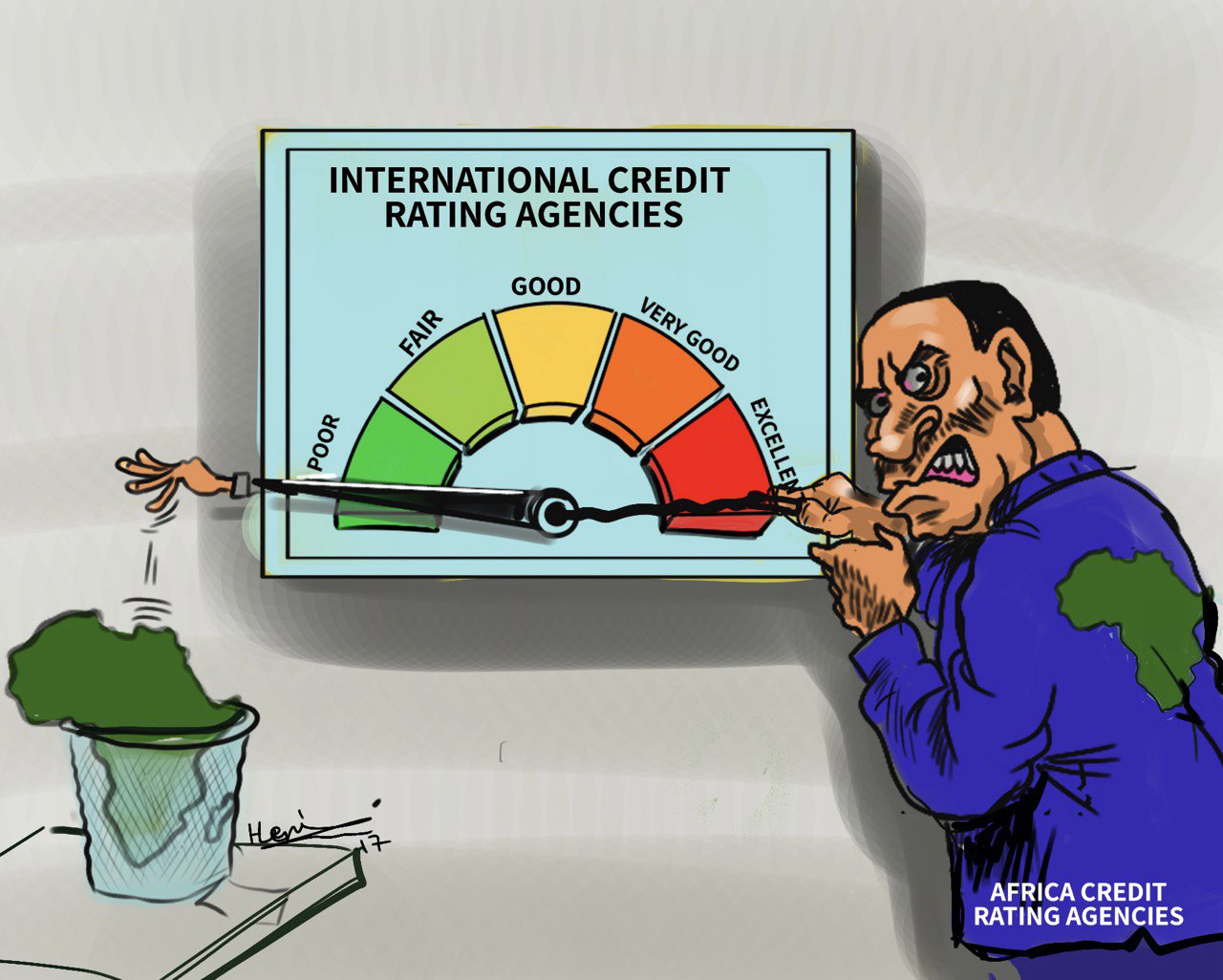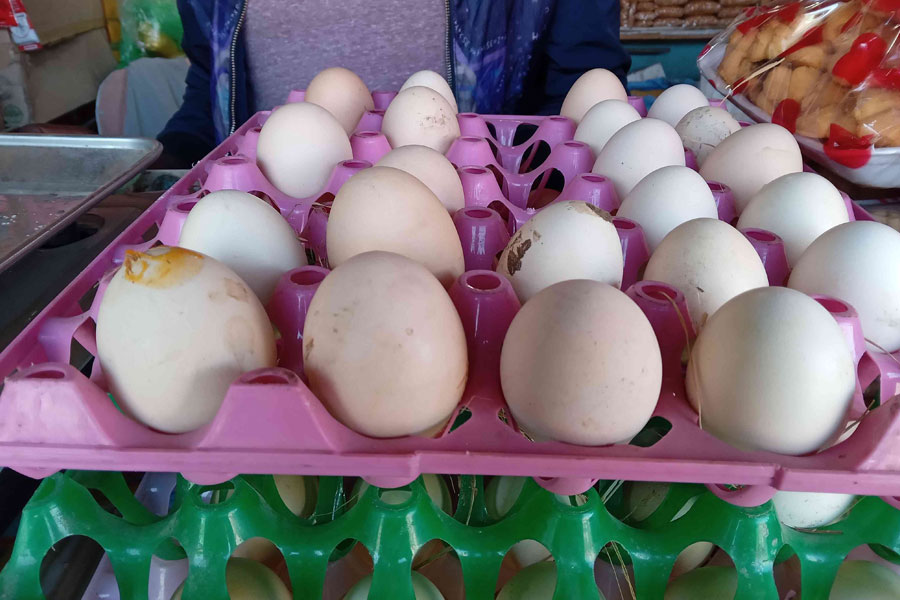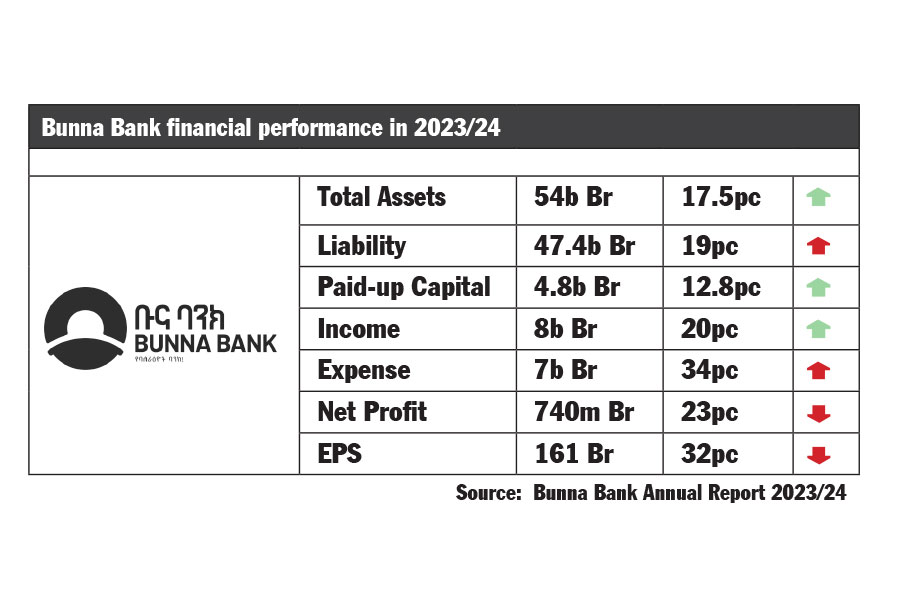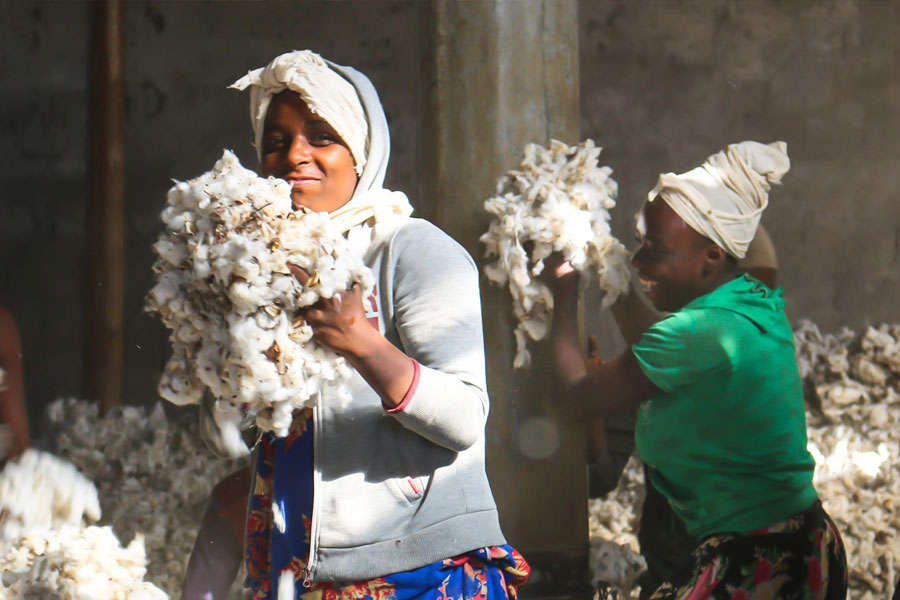Endalk Eshetu stood arguing with a street egg vendor on Russian Street, near Anbessa Gibi Park in Amist Kilo. It was Thursday at 5:30 PM, the peak of rush hour, with long taxi queues as employees left their offices.
The street was crowded with people, street vendors, and heavy machinery working on the nearby road project. The air was filled with dust and the noise of generators. Security officers are selectively chasing away garment vendors.
As Endalk bargained, passersby stopped to ask the price of eggs. Some bought a few; others walked away.
“How much?” Endalk asked the vendor, who was chatting with two peers chewing khat.
“16.50 Br,” the vendor replied.
“Have chickens stopped laying eggs in this country?” Endalk rhetorically asked before walking away empty-handed.
A government employee in his late 30s, Endalk earns 7,500 Br a month. He has a wife and three children. For months, eggs had been his go-to grocery item, especially after their price dropped sharply in April last year. Beef, his family’s preferred protein, had long been out of reach as prices increased. Eggs were the affordable alternative.
“Eggs allowed my family to get good protein with a small amount of money,” he said. “We eat eggs because we can’t afford beef.”
Just two months ago, when eggs cost six to eight Birr each, he bought 20 to 30 a week. Then prices started climbing. When they hit 10 to 11 Br three weeks ago, he cut back. Now, with wholesale prices at 16.50 Br and retail prices reaching 21 Br, he can no longer afford them.
“How can I pay 16.50 Br for a single egg?” he asked.
Even at the government office cafeteria, where food is subsidised, the price of a simple egg sandwich has increased to 50 Br, up from below 40 Br just weeks ago.
“This is with government support, where they rent the facility for almost nothing to keep food affordable for employees,” he said.
Egg prices have surged, making the once-affordable food a luxury for many.
Mezgebu Lakew, a wholesale egg seller near Addis Abeba University’s Yared School of Music, has been in the business for six years. He now sells eggs for 16.50 Br each.
“Eggs are the easiest meal, especially for bachelors,” he said. “You just boil them, no salt, pepper, or spices needed.”
Since the Genna holiday (Christmas), prices have steadily risen. Mezgebu used to serve customers from all income levels, but that has changed. As prices jumped from 11 Br just weeks ago, low- and middle-income buyers vanished.
“Only those who can afford it buy eggs now,” he said.
Many potential buyers stop at his shop, ask the price, and leave disappointed.
“People with limited financial capacity only ask,” he said. “They no longer buy.”
Despite losing regular customers, Mezgebu’s business remains steady. Wealthier buyers, arriving in cars from distant neighbourhoods, have taken their place.
“My customers now are mostly high-income earners,” he said.
His sales split is 10pc cafes and restaurants, 10pc retail shops, and the rest household consumers. While retail prices range from 18 Br to 21 Br per egg, Mezgebu keeps his prices lower, drawing new customers from across the city.
“I earn just under a Birr per egg,” he said. “But selling in large volumes keeps the business going.”
He sells between 4,000 and 10,000 eggs daily.
“I want to keep customers long-term,” he added.
Mezgebu owns a poultry farm in Bishoftu. He sources eggs from his farm and other local farmers. He also sells chicken meat, offering a whole chicken for 350 Br. Unlike eggs, chicken prices have remained low.
“People don’t usually prefer chicken meat,” he said. “But now, some are switching because eggs have become too expensive.”
The rising cost of eggs is squeezing bakeries, pastry shops, and cake houses. Mina Bakery is among those struggling as egg prices and other ingredient costs soar.
The bakery now sources eggs from suppliers in Bishoftu at 17 Br per egg, more than double the seven Br it paid just months ago.
“We sometimes think about shutting down or relocating to regional states,” said Ayele Fentaw, the bakery’s manager.
Despite rising costs, Mina Bakery has yet to increase prices, fearing it will drive away customers. Ayele has already seen demand drop as people cut back on spending.
“If a customer used to buy 30 loaves, they now buy only 15,” he said. “If we raise prices, demand could fall even further.”
But he knows the bakery can not hold off price hikes much longer. With monthly rent at 200,000 Br and 30 employees, 15 permanent and 15 temporary, the business is under pressure.
“How can we pay rent and salaries in this situation?” he asked.
The problem goes beyond eggs. The prices of other essential ingredients have also sharply increased. Baking powder has jumped from 3,000 Br to 6,300 Br, a 20-litre container of edible oil has risen from 4,300 Br to 5,200 Br, and a kilo of salt has nearly doubled from 17 Br to 30 Br.
“It’s getting harder to survive,” Ayele said.
Other bakeries, including Bilu Cake and Kebe Cake, are also struggling. Both are now considering price hikes in the coming days if egg prices remain high.
Egg prices have spiked in recent weeks, driven by supply shortages, rising feed costs, and increased prices for inputs such as vaccines.
In November 2022, the government launched Yelemat Tirufat, a four-year development programme aimed at boosting agricultural productivity, including eggs, poultry, dairy, and honey. Prime Minister Abiy Ahmed (PhD), speaking at the launch in Arba Minch, stated that the initiative’s goal was to achieve food self-sufficiency. The programme has since provided subsidised improved chicken breeds and training to poultry farmers.
According to government officials and industry insiders, the programme has dramatically increased egg and poultry production. The Ministry of Agriculture (MoA) reports that egg production rose from 3.2 billion eggs in 2021/22 to 3.9 billion the following year, reaching 5.7 billion in the 2023/24 fiscal year. Chicken meat production also grew from 90,000 tonnes in 2021/22 to 112,000 tonnes a year later and 208,000 tonnes in 2023/24.
The government plans to produce 9.1 billion eggs and 240,000 tonnes of chicken meat by the end of the 2025/26 fiscal year.
Yonatan Zewde, head of poultry resource development at the ministry, says egg and poultry production has expanded rapidly over the past three years, with the number of poultry farms doubling since the programme began. He told Fortune that the government has supported commercial farms in expanding production while also encouraging new poultry farmers to enter the sector.
The distribution of improved chicken breeds has also increased sharply. In the 2021/22 fiscal year, 27 million chickens were distributed nationwide. That figure jumped to 42 million the following year and reached 74 million in 2023/24.
The increased production initially drove egg prices down. Last year, egg prices fell sharply, dropping to four to six Birr from producers and six to eight Birr at retail. Before this decline, eggs were selling for 10 to 12 Br each.
Two years ago, egg prices remained relatively stable. However, the government’s intervention in the poultry sector has disrupted market dynamics, with fluctuating supply and rising input costs now pushing prices higher once again, according to stakeholders.
Debre Holland Poultry Plc, Ethiopia’s largest commercial egg producer, has faced severe problems due to market volatility. A subsidiary of Maranatha Farm Plc, the Debre Birhan-based farm produces 26 million eggs annually, supplying eggs, chicks, and occasionally pullets.
Bert Bout, general manager at Debre Holland, says demand has been unstable since the government’s Yelemat Tirufat programme began. Previously, the market was more predictable. Last year, egg prices fell to as low as four Birr, making production unsustainable for small and medium-scale farmers, whose costs averaged eight Birr per egg. Many either switched to chicken meat production or exited the business entirely.
“At one point, profit margins were just 0.5 Br per egg, far too low to be viable,” Bert said.
Tigist Getachew, Debre Holland’s marketing manager, says the egg industry is naturally cyclical, with demand peaking during non-fasting seasons like Christmas and Easter and dropping in winter. Traditionally, farmers sell layer chickens during holidays, which leads to post-holiday egg shortages. However, the government programme disrupted this cycle, forcing many farms out of business and reducing demand for pullets and one-day-old chicks.
Last year, egg prices plummeted due to weak demand. Debre Holland was forced to dispose of unsold eggs. The farm, which benefits from economies of scale, produces eggs at six Birr each, two Birr lower than the average small or medium-scale farm.
As farmers abandoned the industry, demand for Debre Holland’s chicks and pullets also collapsed. Bert says that the only reason the farm survived was its large-scale operation and self-sufficiency in feed production.
“The market volatility has been brutal,” he said. “Low prices last year wiped out many farms.”
He says that the country is facing an egg shortage now because there are too few layer hens.
This shift has driven egg prices up, while chicken meat prices have dropped. Many farmers, who previously switched to broiler production, are now scrambling to re-enter the egg market.
“The demand is crazy now,” Bert said. “Everybody is calling me for eggs.”
Alemayehu Amdemariam (Maj.), co-owner of Alema Farms, a large-scale poultry farm in Bishoftu, predicts a similar trend for chicken meat. As meat prices fall, many farmers are halting chick purchases and stopping production.
“Very few people are buying chicks from me,” he said. “The demand for broilers and chicken meat has dropped enormously.”
If demand remains low, he expects to shut down production soon. They are already storing chicken meat due to oversupply and weak sales.
Many are now urging Alemayehu to shift to hatching layer chicks instead.
Seid Mohammed (PhD), manager at Albar Poultry, says his farm hatches both broiler and layer chicks, operates a feed factory, and produces eggs.
At times, they hatch hundreds of thousands of chicks, but when prices drop, they halt production. Most of their customers are small-scale farmers who struggle to survive.
The price of layer chickens has skyrocketed recently, according to Seid.
“There were times we begged customers to buy chicks,” Seid said. “When prices drop, you’re desperate to sell. Now, it’s the opposite, we are being begged for chicks. Demand has exploded.”
But Seid is sceptical.
“The market is crazy right now,” he said. “But my experience tells me it will not last.”
Yonatan believes middlemen are driving up egg prices, but he expects them to fall soon.
As demand for layers surges, interest in broilers has collapsed. Many farmers are abandoning the broiler business, suffering heavy losses. Last year, chicken meat prices spiked, attracting new entrants, but now, the cycle is reversing.
“People jump into poultry farming and switch between egg and meat production without proper research,” Seid said.
Fikadu Bekele, a poultry farm owner in Sebeta, Oromia Regional State, says the rising price of eggs has sparked a rush into poultry farming. This surge in demand has driven up the cost of layer chickens. A one-day-old chick now costs 103 Br, while a two-month-old layer sells for 350 Br.
Many of Fikadu’s colleagues have been forced out of broiler farming and some are switching to egg.
Commercial poultry farms that operate year-round are rare. According to the Ministry, most eggs come from household farms, followed by small and medium-scale producers. Only a handful of large-scale poultry farms, such as Elfora, EthioChicken, Maranatha, and Alema, remain.
When prices drop, small and medium-scale farmers cannot afford to operate at a loss. Large farms endure because they can absorb short-term losses.
Large farms operate at a loss until small-scale farmers are forced out of business, causing egg prices to rise again.
“You can’t escape losses in this business,” Seid stated.
Hatcheries were forced to dispose of eggs and one-day-old chicks. In just four months last year, eight large and medium-scale poultry farms lost 292 million Br, according to Zinaw Tsehayneh, general manager of the Ethiopian Poultry Producers & Processors Association (EPPPA).
“They can keep running even at a loss, but small farms can’t survive,” Zinaw said.
Alema Farms, which sells layer chicks, produces feed, and raises broilers, also struggled. Six months ago, they could not find buyers for their layer chicks and had to halt hatching.
“I lost millions of Birr as a result,” said Alemayehu.
The Ministry reports that 4.5 billion eggs and 105,000 tonnes of chicken meat were produced in the first six months of the fiscal year. However, poultry farmers are sceptical about these figures, arguing that actual production is far lower.
A major driver of rising egg prices is the sharp increase in feed costs. Prices have surged due to several factors, including the introduction of VAT and rising costs of imported premix. For years, feed and eggs were VAT-exempt, but Parliament ratified a new VAT law last year, increasing costs, especially for small farms.
The soaring cost of feed has made the poultry business increasingly difficult.
At Debre Holland, feed alone makes up 70pc of production costs. The primary ingredients, corn and soybean, are sourced mainly from the Wollega zones of Oromia Regional State and the Gojjam zones of Amhara Regional State. Conflict and instability in these regions have disrupted supply chains, further inflating prices.
Feed accounts for 80pc of poultry production costs, making its rising price a major burden on the industry. Last year, the Association requested the government to lift VAT on poultry feed, but so far, no response has been given.
“The main problem is the rising price of feed,” Seid stated.
The prices of key feed ingredients such as corn, soybean, premix (vitamins and minerals), press cake, and bran (frushka) have risen sharply. Soybean now costs 6,000 Br per quintal, while poultry feed exceeds 5,000 Br per quintal, up from 4,600 Br just six months ago.
Feed factories make little profit due to the rising cost of inputs like corn and soybean and an unstable supply chain, according to Said. He says they earn a maximum of 350 Br per quintal of feed.
Zinaw says feed prices have also risen sharply due partly to increased corn exports, logistical hurdles, and security threats.
Imported inputs such as parent stock, vaccines, vitamins, and minerals have also soared in price, mainly due to the depreciation of the Birr. Prices have jumped by 100pc to 300pc in a year. A parent stock that cost 20 Br four years ago now sells for 80 Br.
While locally produced vaccines exist, Zinaw says they are less effective because they must be administered separately. Imported vaccines, on the other hand, are combination doses that protect against multiple diseases at once.
Antibiotic prices are also increasing. A single vaccine dose now costs over 1.40 Br, with vaccinations required every three months. Egg layers receive daily antibiotics to boost productivity, further driving up costs.
Farmers struggle due to the lack of a sustainable market. Demand is seasonal, peaking during holidays, while instability in various regions disrupts transportation. As a result, most producers are forced to sell only in the capital.
There are no logistics or refrigerated transport facilities to distribute poultry products nationwide, according to farmers. Storage facilities for meat are also lacking, making it difficult to manage supply when demand drops.
Lack of access to foreign markets has also worsened the problem. Poultry exports are restricted. Yonatan says the restriction is meant to prioritise domestic demand.
“We need to boost production first before considering exports,” he said.
However, Zinaw argues that limited market access forces many farmers out of business, ultimately leading to supply shortages.
The Association, which represents over 160 members, has formally requested the Prime Minister’s Office and the MoF to allow the export of one-day-old chicks, broilers, and pullets.
A lack of direct linkage between producers and consumers is another factor preventing producers from gaining large profit margins. Middlemen dictate prices, reaping most of the profits while producers earn little.
“The market is at the mercy of middlemen,” Fikadu said.
Conflict across the country has also severely impacted the poultry industry, particularly in the Amhara and Tigray regional states.
Gerado Poultry Farm & Animal Feed Factory, the only private commercial poultry farm in the Amhara Regional State, has been shut down since the war in northern parts of the country expanded four years ago. Located in Dessie, the farm used to hatch a million layers annually. Established in 1998, it was a key supplier in the regional state.
However, during the war, the farm was vandalised, machinery and feed were looted, and 100,000 chickens, including 17,000 layers, were stolen. The total losses amounted to 85 million Br, according to its owner, Ibrahim Aden.
The farm remains non-operational. Ibrahim told Fortune that he needs 300 million Br to restart operations and has applied for a loan from the Development Bank of Ethiopia (DBE). He is also exploring partnerships with other farms, but ongoing instability in the region poses security risks.
Any fluctuation in feed prices immediately impacts the poultry industry, as feed accounts for over 70pc of production costs, says Demeke Wendimagegn (PhD), a poultry expert and former director at Ethiopia-Netherlands Trade for Agricultural Growth (ENTAG).
Five years ago, a quintal of feed cost 1,500 Br, but prices have since skyrocketed. Demeke argues that the introduction of VAT has further affected the sector, adding over 600 Br per quintal.
He says a recurring pattern has occurred over the past decade, new farmers enter the market each year, but the sector remains unsustainable. Most are small-scale farmers with limited capacity, typically raising between 1,000 and 2,000 chickens. Lacking economies of scale, they struggle with high costs, enter the market quickly, and exit just as fast, destabilising supply and demand.
These small-scale farmers also lack the necessary skills and knowledge to run poultry farms efficiently. As a result, productivity remains low, only 50pc to 60pc, causing financial losses or minimal profits, forcing them out of business. According to Demeke, egg production should be at least 80pc for farms to be viable.
He recommends that instead of having 100 small farms with 1,000 chickens each, farmers should consolidate resources to establish large-scale operations with 100,000 chickens, making production more efficient and sustainable.
Currently, small and medium-scale farms contribute over 70pc of Ethiopia’s egg supply, Demeke said.















 Loading your updates...
Loading your updates...